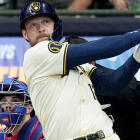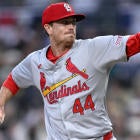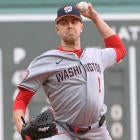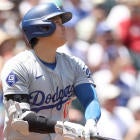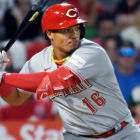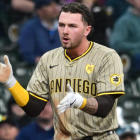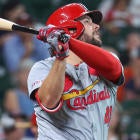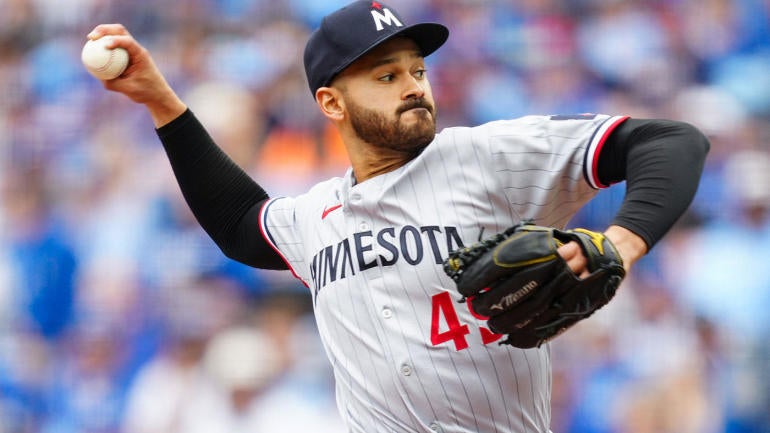
There's been an awful lot of attrition at the top of the Fantasy Baseball rankings in the first two months of the season. The top hitter (Ronald Acuña) and top pitcher (Spencer Strider) are both gone for the season. Trea Turner, another first-rounder, has been missing for weeks, as has third-rounder Luis Robert, fifth-rounder Mike Trout, and mid-round picks like Royce Lewis and Nolan Jones, and that's just a sample of the big-name players who have hit the IL – and it doesn't include all of the star pitchers who went down before the season even started.
If you have managed to avoid the worst of it so far, congratulations. I'm sure there are dozens of you out there who have managed to sidestep the landmines out there and are doing great. If you have, you're well-situated to take advantage of that by buying low on some struggling stars who can make your roster look even better.
And if you've been hit hard by injuries, your best and maybe only hope of turning it around is to identify some struggling stars you can buy at a discount in the hopes they'll get hot and turn your season around.
Which is to say, no matter where you're sitting in the standings, targeting buy-low candidates in trades makes a ton of sense. Here are four big names you should be looking for in trade, with my thoughts on how and why they're going to turn things around moving forward.
Pablo Lopez, SP, Twins
Coming off a breakout season, Lopez was drafted as a top-10 starting pitcher in pretty much all leagues, and he hasn't been anything close to that so far, ranking 64th at the position in CBS Roto leagues, behind such luminaries as Brayan Bello, Bailey Falter, and Charlie Morton, among, well, many others. Lopez is still doing a lot right, with a 27.7% strikeout rate that ranks in the 79th percentile and a 92nd percentile walk rate of just 4.0%. That's led to a really nice 1.17 WHIP, which means the primary issue here is fairly obvious: His ERA is super inflated, at 5.25 through 11 starts.
And you can probably guess why that is: He's giving up too many homers. Lopez is up to 1.5 HR/9, significantly higher than his 1.11 mark from last season (which is also his career mark, coincidentally). And that's not just a fluke, as Lopez is both giving up more fly balls and worse quality of contact than last season, a bad combination, obviously.
But the thing to keep in mind here is that Lopez's biggest blemishes right now – his inflated home run rate and the inflated ERA that has resulted from that – are issues that tend to be least predictive for pitchers. Home runs are bad for pitchers, but they are also relatively rare events that can have an inordinate effect on ERA without necessarily indicating a change in skill set. In Lopez's case, there are some red flags to be found,especially with his fastball, which has accounted for five of his homers allowed while seeing a jump from 90.5 mph and a 19-degree average launch angle last season to a 27-degree launch angle and 91.5 mph average exit velocity. He's giving up more fly balls and those fly balls are coming off the bat harder. That's a bad thing.
But, the overall numbers overstate the extent to which his skill set has regressed. BaseballSavant.com's expected ERA metric has Lopez at 3.25, two full runs below his actual mark, and that is the metric that best accounts for quality of contact allowed. That still shows regression in the skill set from last season, when he had a 3.00 xERA (in an offensive environment where more runs were being scored), but is also a pretty good indicator that Lopez probably deserves better results moving forward.
That's not to say Lopez is fine or doesn't need to improve, of course. One thing that stands out is that, when Lopez is missing, he's missing more in the heart of the zone – his middle-middle location rate, per PitcherList.com is 7.8%, up from 6.5% last season and 6.7% for his career; that's a small change, but it could help explain why Lopez has struggled. His stuff still looks very good – PitcherList's PLV stat, which focuses on pitch quality alone, not results, ranks him 17th in that metric this season – but he needs to execute better. Given how good he was last season, I'm very willing to bet on Lopez figuring it out. He feels like the most obvious buy-low candidate in Fantasy right now.
Francisco Lindor, SS, Mets
When it comes to established veteran stars, the first thing I look for when dealing with an unexpected performance – before I even look into their underlying data – is to see whether we're seeing something truly new from them. In Lindor's case, the slow start has become a feature of Lindor's Mets career. Let's just take a look at how he has hit in April and May the past few months compared to the rest of the season:
- 2021, April-May: .194/.294/.294; ROS: .252/.340/.482
- 2022, April-May: .260/.346/.444; ROS: .274/.335/.452
- 2023, April-May: .223/.294/.427; ROS: .272/.360/.495
What that tells me is I probably don't even need to look at the underlying metrics to see if you should buy low on Lindor in light of his .210/.279/.367 line; you should. I don't have a good explanation for why Lindor has struggled so much in the early months since getting to the Mets – the early-season weather in New York isn't any worse than it was when he was in Cleveland, and he wasn't routinely posting sub-.700 OPSes in the spring back then – but the fact that it's happened in two of the three prior years before he turned it around seems like a pretty good reason to dismiss it.
Of course, the fact that Lindor has been one of the biggest underperformers in the league when you do look under the hood is just confirmation of his buy-low status. Lindor has a miserable .287 wOBA right now, but his expected mark is .346, right in line with last season and his career norms. Now, it's possible that Lindor might be uniquely impacted by an offensive environment where the ball isn't traveling as far as it has in years past, a hypothesis we can't dismiss out of hand, though I'm not certain the ebbs and flows in Lindor's production have historically aligned with the relative bounciness of the ball; his best season came in 2018, for example, while the ball was at its bounciest in 2019, for example.
Which is to say, I think the case for Lindor turning it around is pretty crystal clear, and if there's any kind of discount available, I'll take it.
Austin Riley, 3B, Braves
The perfect moment to try to buy Riley has probably already passed, now that he's back from the intercostal strain that cost him two weeks and which seemed perfectly calibrated to frustrate Fantasy players, as the Braves just refused to put him on the IL over the course of a two-week injury. Riley was back in the lineup Monday and hopefully will be fine moving forward, but I still think this is a great time to try to buy on a guy who has established himself as one of the best hitters in baseball over the past few seasons.
Now, this is one situation where I don't have a ton of fancy stats to point you to and say, "See, Riley is fine!" There's probably been a bit of bad luck in his production to date, of course, with his .307 wOBA trailing his .332 expected wOBA significantly. But that .337 mark is more than 30 points behind what he managed between 2021 and 2023, and his average exit velocity has dipped from 92.3 mph last season to 91.1 so far. He just hasn't been quite as good … and I just don't really care.
Players like Riley have proven themselves to be good enough to where I really don't need to look at those underlying numbers. I'd prefer they be closer to his established baseline, of course, but the thing you have to keep in mind here is that talent fluctuates, too. In the parlance of old-timey baseball, sometimes guys are just cold; they just aren't locked in. That's the case for Riley, but as long as he is healthy – and I have to assume he is after the Braves spent two weeks playing a man down – I have faith that Riley is going to be fine. I'm still valuing him as a second- or third-round caliber player.
Blake Snell, SP, Giants
And now, here's the most extreme version of what I've spent most of this column talking about, where I'm still trying to buy Snell despite having very little positive to say about him. In fact, I don't think I can say anything positive about him right now; Snell's 24.7% strikeout rate is his lowest since his second season in the majors; his 11.3% walk rate would be his fourth-worst mark ever, and obviously, I think it goes without saying that his 10.42 ERA is the worst in baseball right now.
It's also not even the worst stretch of Snell's career, believe it or not. He had a five-start stretch with an 11.94 ERA back in 2019, and has had two other stretches with an ERA over 9.00 over five starts. But, if you've been following Snell's career at all, you know that he tends to follow up his worst stretches with stretches of absolutely brilliance; he followed up that 11.94 ERA stretch in 2019 with 31 strikeouts in 22 innings over his next four starts with a 1.64 before landing on the IL. And, in 2021, his ERA peaked at 5.72 for the season after he gave 22 runs over a 21-inning stretch, only to immediately turn around and put up a 2.81 ERA over his final 13 starts of the season.
We could spend time trying to identify what is wrong with Snell, but I think the lesson here is … this is just who he is! It's who he has always been. He's never been able to find consistency, which was why I had very little interest in buying him at his Cy Young winner cost this spring – I did end up drafting him in a few spots when his extended free agency exile lingered, which … yaaaaay.
But he's going to figure it out. Snell's track record should make us very confident in that, though people always seem to forget that – when he was struggling around this time last year, he got dropped in countless leagues. I would be surprised if that happened anytime soon for Snell this time around, but I also can't imagine it's going to cost much to trade for him. Go put out some offers just to see if you can turn someone like Reynaldo Lopez or Reese Olson into him.










